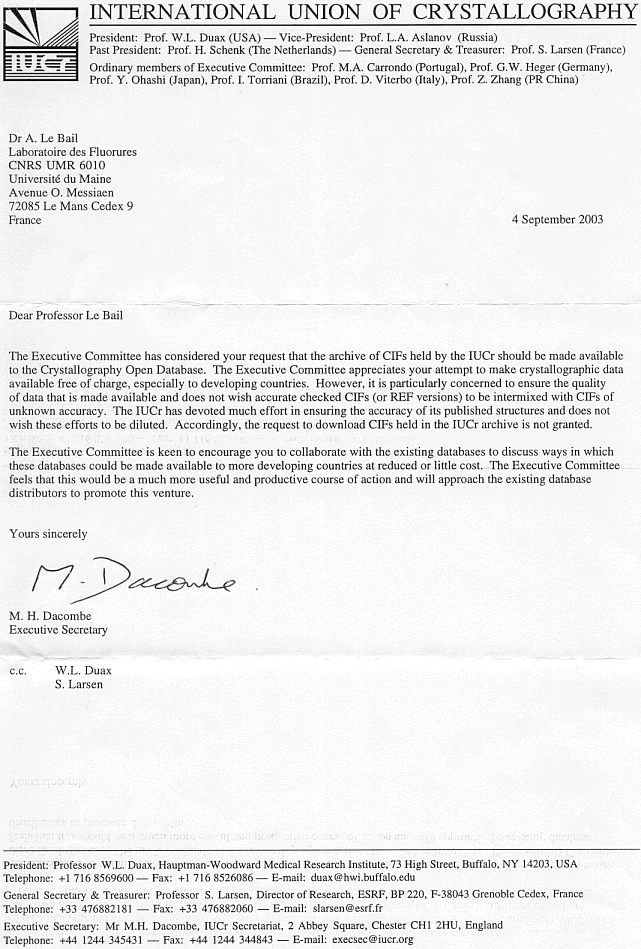
 June
30, 2003
June
30, 2003Crystallography
Open Database
http://www.crystallography.net/
Email
: cod@cristal.org
Dear
IUCr Executive Committee Members,
In
August 2003, the Advisory Board of the Crystallography Open Database (COD)
will request permission for unlimited access to the IUCr CIFs. The CIFS
are presently available by free access at the IUCr journals web server.
With this letter, the COD Advisory Board Members wish to explain their
motivations, and why and how they believe that this new global database
will become an invaluable tool for the International Community of Crystallographers.
Our
IUCr President writes in the Newsletter 10-4 (2002): "Emerging nations
can benefit from the use of the powerful techniques of X-ray crystallography
in order to analyze, understand and use the unique natural resources within
their countries whether mineralogical, chemical, or biological in nature".
As stated in the first letter sent by the COD Advisory Board Members to
Bill Duax (April 2003), this generous wish could more easily be achieved
through free access to a global crystallography open database (including
all inorganic, metallic, organometallic and organic compounds) which is
the purpose of our new COD web server located at http://www.crystallography.net/
offering atomic coordinates in the IUCr CIF files format, together with
a search engine.
The
initial position of COD was to develop the database through individual
or laboratory-based contributions. Rather than systematically copying the
atomic coordinates from the literature, individual authors and laboratories
are encouraged to send their own CIFs. Thanks to a few major donators (the
American Mineralogist Crystal Structure Database for >4000 entries, the
Institut de Physique de la Matière Condensée -Grenoble- for
>1200 entries, the CRISMAT -Caen- for >850 entries and the Laboratoire
des Fluorures -Le Mans- for >450 entries), as well as to many individual
contributors, the COD already contains more than 12.000 entries. This is,
however, only 3% of the 400.000 known published structures. Permission
from IUCr would more than double the current COD content.
Currently,
a search in COD is completed by two powerful options:
-
Combining in any logical
way: text, cell volume, chemical elements and strict number of elements.
- Cell parameters ranges amin-amax, bmin-bmax, etc.
We
will ask the IUCr for one of two options:
-
Permission to include
CIF data in the COD database.
-
Permission to construct
REF files from the IUCr’s CIFs that include the reference, chemical formula,
cell parameters and space group. Then a search on COD that returns a structure
published in IUCr journals will return a hyperlink to the CIF at the IUCr
web server. Thus the CIF does not need to be on the COD server side since
it is already freely available at the IUCr journals server side. In this
way, COD can serve as a search engine to the IUCr journals. As a test,
the COD is already pointing at the IUCr web site for the Acta Cryst. C
1991 and 1992 CIFs.
There
are some data quality issues that need to be considered. Currently, COD
expects a donor to upload to the COD only his best data (CIFs as built
by the refinement software, and thus free of typos at least on atomic coordinates
and cell parameters). We assume that the donor of the data does the quality
check. The COD is confident that Crystallographers will demonstrate a high
degree of professionalism and autonomy.
About
durability of the COD, the current ten Advisory Board Members offer some
guarantee. The open nature of the COD, which can be downloaded either in
part or completely, including all data and source code, is also an argument
favouring its survival. The whole COD system is based on open source software
(Apache/MySQL/PHP) and can be used by interested parties (contact cod@cristal.org).
It is simple to install and would be quite useful to laboratories wanting
to build a crystal database from their own crystal structure determinations,
for either an intranet or an internet external access (or for building
any crystal subset of interest to specialized Crystallographers such as
zeolites, phosphates, fluorides, nitrates, carbonates, sulphates, etc).
Collecting all such laboratory fragments in the global COD would offer
an invaluable service to the world crystallographic community and particularly
in emerging nations. The CRYSTMET, ICSD and CSD databases offer much more
complete and powerful services than COD, which is limited to the minimum
information allowing a crystallographer to survive at low cost. Even crystallography
journals (not only IUCr journals) may decide in the near future to open
their own database of published crystal structures in a searchable way.
The journals interest is to sell articles, so that it seems clear that
they may decide to open a database limited to REF files, the client wanting
atomic coordinates would have to buy a copy or the published paper. REFs
may include compounds in the COD that were not completely structurally
characterized (no atomic coordinates, but with chemical formula, cell parameters
and space group proposed by isotypy with a fully characterized analogue,
etc). In this way, the COD would even be more complete than databases distributed
for fees.
With
this letter, we have presented to you a vision of free and easy access
to the crystallographic data via the Internet. Once the database has developed
to some maturity, it is our dream that its use will promote the science
of crystallography at all levels of education and to all parts of the world.
We envision the use of software, intimately associated with CIFs that will
promote and ease the interface to understanding our exciting profession.
We hope that as members of the IUCr executive committee, you can share
our vision and grant COD access to the data files published in the IUCr
journals. For more details about the COD, REF files and so on, visit the
web site: http://www.crystallography.net/
Sincerely
yours,
The
COD Advisory Board :
M. Berndt (Germany), D. Chateigner
(France), X.L. Chen (China), M. Ciriotti (Italy), L.M.D. Cranswick (Canada),
R.T. Downs (USA), A. Le Bail (France), L. Lutterotti (Italy), H. Rajan
(USA), A.F.T. Yokochi (USA).